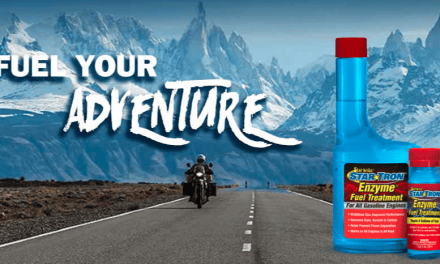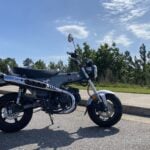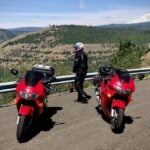Living With The Tuning Fork’s Remarkable Sport Tourer
A salesman at a motorcycle dealership once confided in me, “To really familiarize yourself with a motorcycle, really get to know it, you need to live with it for a while. Take it home with you, ride it all day, wake up to it the next morning and ride it some more. A short 2-3 mile test ride really isn’t enough to get a true feel for a bike.” I’ve come to agree with him. Whenever we get a motorcycle to review, we try to keep it for at least a month for that very reason. The better we come to know the bike, the better we can communicate it to you.
So when Yamaha offered us a brand new 2024 Tracer 9 GT+ for two months, we jumped at the chance. I was not very familiar with this model, although I knew the 890cc triple mill from our time with the XSR900, a retro-styled bike I absolutely loved. Gerrad with Yamaha personally delivered it two days before I turned the big 6-0, exclaiming, “Happy Birthday Rob! I come bearing gifts!” He offloaded the Tracer 9 GT+, then handed me a LEGO MT-10 kit for us to build and do a story on for the holidays (more on that forthcoming). So with his final admonition to “ride the crap out of it, put a bunch of miles on it”, he handed me the key, and our adventure began.
The Tracer at rest in my driveway. It wouldn’t stay at rest for long.
While the bike bears some semblance to a sport adventure bike (think Triumph’s Tiger Sport 660, for instance), the Tracer 9 GT+ is pure sport tourer. So tour it we did- quite sporty at times too, I might add. I had been slightly intimidated by it when Gerrad first delivered the Tracer, thinking back to the Tenere 700 we had the previous year that I dropped a couple of times, being too tall for me to ever get comfortable on, but I soon discovered my mild anxiety was wholly unfounded. With adjustable seat height, bar reach, and footpeg positioning, I found that at 5’8” I could mostly flatfoot on it, and the rider triangle of lowered seat, pegs and grips was a comfortable position for me. Phil felt slightly cramped on it, but at 6’2”, Phil feels cramped on most bikes under a liter cc’s.
I rode the Tracer 9 around for a few days, commuting, errand running, and afternoon buzzing out into the local countryside with it to get acclimated to its features and handling. By the time Lyle and I left for our “6-0” road trip, I felt fully prepared to log some miles and days in the saddle. Upon my return home from it, I absolutely loved the Tracer. Some motorcycles, when a journalist is finished road tripping it, the bike is left in the garage for others to sample or the loaning brand to retrieve. The true measure of how much a journo likes a bike is by how often they return to it, even after the story/video review is done.
I had to ride the Tracer 9 GT+ more. Once was just not enough. I loved it.
Riding the Cumberland Gap Scenic Byway in Kentucky. Man and machine are one.
So when another old high school chum, Ken, invited me up to hang out with him at their home back up in the north Georgia mountains on a subsequent weekend, I loaded up the Tracer and rolled north again, eager to ride the bike some more. Then a few weeks later, Mike Boyd and I headed to Barber Vintage Fest to cover the motorcycle sidecar racing for a story, and of course, I had to tour the Tracer to Birmingham and back for it. I just could not get enough of riding this bike. That’s how much I’ve enjoyed it.
So as I sit here and put words to our “long-term review” of Yamaha’s 900 sport tourer, I’ve just finished washing a couple thousand miles off it, cleaned and lubed the chain, then just stood there looking at it, barely resisting the urge to grab the keys and throttle out again. Might still do that here shortly…
Giving the Tracer a bath after three road trips, before giving it back. Maybe one more ride?
Ted had the opportunity to attend the North American debut of the 2024 Tracer 9 GT+ back in August out in Boise ID, and raved about the Adaptive Cruise Control. And after road tripping the bike three times, that’s what I came to appreciate the most about the bike as well. As of this review, I believe Yamaha is only one of two or three brands offering some form of ACC on a bike. By 2025, this will be standard fare on most other brands with bikes running cruise control, I’d be willing to wager. Yamaha’s ACC is perfection, pacing the vehicles in front via their radar-linked cruise and braking system, and adjusting the suspension and geometry accordingly with the speed maintenance. Like Ted said, incredible.
Road Dirt editor-at-large Ted Edwards rolling a Tracer 9 GT+ outside Boise, ID. Photo by Yamaha.
One element I didn’t pick up on until a stint of night riding, are these small running lights that illuminate further into corners as you lean over, then cut off when upright again. What a cool feature for riding after sunset. I also mistakenly thought one of the running lights was out on the bike Ted rode in Boise, examining the video footage, only to realize only one lower light is illuminated when running low beam, but both are on when riding high. I never like single light low beams on dual headlight bikes, as I’d prefer just lower lumen beams on both. That was one of the few negatives for me. That and I’m not a fan of the front “Transformer” looking fairing and lights design. Function trumps form with this bike, in my opinion. It’s not very pretty up front to me. Phil disagreed, loving the “aggressive” look. Either way, it’s function is outstanding.
Up in Marble Hill, Georgia, at my friend Ken’s place.
Like most modern motorcycles these days, the Yamaha Tracer 9 GT+ has multiple ride modes, but I must admit, I rarely rode in anything but “STREET”. It held the perfect balance of throttle response, braking application, and suspension geometry for road tripping. It’s got a jumpy “SPORT” mode if you’re feeling froggy, but STREET was froggy enough for me out riding. I did use “RAIN” for the brief stint we did in some wet south of Corbin, Kentucky, but not enough to really review it.
Gerrad had helped me Bluetooth pair my phone to the Yamaha system, but when I turned on my Cardo unit for the road trip, I never figured out how to make the Cardo speakers the output. I got only silence in my headset, while the Yamaha TFT screen showed music was playing. Someone with more tech savvy than me could figure that out, I’m sure. When I un-paired my phone from the bike, all was well in my helmet and cranium. I think the Tracer was fine with it too, as I’d been pushing too many buttons in the menu.
Everything at the touch of a toggle.
Speaking of menu, the left grip toggle switch makes accessing and navigating the menu super easy. Screen customization, traction control settings, etc., are all brought up by the toggle switch. This is one of the simpler menus to access and move through that I’ve used on a bike in quite some time.
I also really appreciated the Yamaha quickshifter/slipper clutch setup. Clutchless shifting up through the six speed gearbox is super smooth, but it honestly felt a bit clunky when downshifting without the clutch. I timed the downshifts and give a slight blip to the throttle to make them seamless. With a little more fine tuning, this could be solved. I found myself rolling clutchless when upshifting, then used the clutch when downshifting.
It’s a big screen, but I like it. Chasing Lyle somewhere in northern Tennessee.
The large single TFT screen is outstanding, replacing the previous model’s two screen setup. It’s a non-glare surface as well, which is very helpful when the sun is at your back. Given that this screen is the size of an iPad Mini, glare from the sun would be a definite problem. The windshield behind it is manually adjustable up and down, and easy to do even at speed. I also appreciate the USB port right below the TFT dash, which made keeping a phone charged easy while affixed to my RAM Mount X-Grip on the handlebar.
I found the seat a bit hard and unforgiving on long days out riding. It looks more plush than it really is, or it just might be my scrawny posterior to blame. Seat height is adjustable underneath, and Yamaha had set it to the lowest notch at 32.3”, which worked well for me. The tank holds 5 gallons of petrol, so I was able to get close to 250 miles on a tank (I usually stopped at 200-220 miles), at a pretty consistent 50 mpg. The mileage was impressive to me, given the “heavy wrist” speeds I often rode at.
The Tracer chilling while Mike Boyd & I put around Barber Vintage Fest on a Monkey and a Metro.
The hard cases on the Tracer 9 GT+ are among my favorites on a sport tourer. They are easily lockable/unlockable, and easy to remove and replace. I’m not sure what their capacity is, but I could store a full face helmet in one. I loaded them up on each road trip, and only strapped a tail bag to the back seat for jackets, snacks, and camera gear.
That cross plane inline triple 890cc engine is outstanding for eating miles at freeway speeds, and the growl/howl it emits when on the throttle is rousing. I love a triple mill anyway, and the throaty nature of this Yamaha powerplant is quite satisfying. It makes about 108 ponies at 10K rpm, and puts down 63 ft lbs of torque to the rear wheel at 7200 rpm. It’s a thrilling rip out on the open roads.
The hard cases are outstanding on this bike.
With so many other features I didn’t even touch on here (see Ted’s review for the KYB semiactive suspension, lean angle sensitive TC, front wheel lift control, etc.), this bike would serve well as someone’s “do-everything, go-anywhere” sport tourer. I kind of hate giving this one back. We’ve bonded, the bike and me. Maybe I can get Yamaha to loan me one for a big “Pacific Coast Highway” trip Ted wants me to take with him next summer. This Tracer 9 GT+ would be perfect for it.
Rob
For more on the 2024 Yamaha Tracer 9 GT+, click here:
Here’s our final impressions video:



































I would be greatly interested in knowing how wind protection is for two up riding, otherwise I’m leaning to an RT. We would also like to do a two up ride on PCH, riding a Concours now.
The stock windshield is rather narrow, but we believe taller, wider replacements are available.
Live in MS and bought a new 2019 Tracer 900GT sight unseen other than online – from a dealer in Portland OR. Flew out and rode it back some 2600 miles mostly back roads. Awesome trip with a great bike – new ones make me drool but not getting one yet.
Fantastic, Marshall!
Yeah, we love this new iteration of the T9GT+. Amazing motorcycle.
i found on my 2023 XSR 900 that the quick shifter works very well on downshifts if you don’t try to outsmart it.. as you downshift, it grabs enough additional RPMs to smoothly access the lower gear if you just let it by not using clutch or throttle. if you invoke throttle or clutch it doesn’t use it’s superb quick shift routine and gives you what you think you are asking for.. just thought i would respond to what i discovered on my CP3 engined 900. Kevin.. 70 year old enthusiast. Spokane Wa.
Good word, Kevin. Is there a best RPM in each gear that clutchless downshifts seem the smoothest?
I’ve had a couple BMWs with quick-shifters. On them, you must close the throttle to activate the quick shifter. If you’re not doing that, that’s probably why you’re not happy with auto-downshift.
Yet Yamaha reps and the bike’s spec and details sheets state that seamless upshifts and downshifts are possible with no modulating or modifying throttle position. To be honest, our observation was barely a complaint. Every one of us who rode it loved the quickshifter setup, even if it was a slight bit heavy on downshifting.
I totally disagree what you wrote about the quick shifter and I am almost sure that it was due to lack of experience. I am riding my second Tracer9 GT and now the GT + and I can definitely assure you that the Quick shifter is working smoothly up and down. It should be done by quick kicking. The quick shifter is a great tool for active security, it is so smooth that it can be used for engine breaking instead of using the breaks .
When we first procured the bike, it had 33 miles on it. We took some time to break it in smoothly, as quickshifting felt a bit heavy on the downshifts. As of this day, we still have the bike, and both up and down shifting with the quickshifter has smoothed out.
Thanks for the thorough review. Seems like it ticks most of my boxes. How much vibration did you get at highway speeds–70-75 mph–compared to other sport tourers, and was it bothersome?
Also, what rpm is it running in top gear at those speeds? Thanks.
Thanks, glad you liked our review!
Vibration at highway speeds was really inconsequential. Mirrors vibrate slightly at 75-85 mph, but not annoyingly so.
The T9 is tuned and geared differently than the MT-09 and XSR900, which are very rev-happy. The powerband in each gear in the T9 is broader, more linear, and I think rpms at 80 mph(+-) was about 5K-6Kish, if my memory serves me.
Thanks for chiming in!
Thanks much!
What a fantastic and thorough review! The Yamaha Tracer 9 GT+ sounds like an incredible bike, especially for long road trips. Your detailed experience makes me want to take it for a spin myself. The adaptive cruise control and cornering lights are standout features. Thanks for sharing your journey with this impressive sport tourer!
Thanks Hank! You’re very kind.
Take a spin on one! We’re sure you’ll be impressed too.
Great review, i’m driving my GT+ since June 2023 and did 12’000km so far. I can agree with anything you write. I’m also really happy with the reduction of windnoise due the larger stock windshield with the small extra shield on top of it (i’m 1.80m tall).
The quickshifter is a great piece of tech, i barely use the clutch lever at all. But if you don’t shift vigorous enough, it’s getting stuck between gears, happens in 1 of 500 shifts for me.
Greetings from Switzerland
Glad you’re enjoying the T9GT+, Daniel!
Agreed, fantastic motorcycle.
Blessings on you in Switzerland!
Have my Yam T9GT+ since july 23 , have 9500 km on it and travelled the North Coast 500 in Scotland and just finished a Moezel-Black Forest- Vogezen-Luxemburg trip.
Rob’s detailed review is very accurate. It’s a really awesome motorcycle. Radar cruise control is impressive. Quick shifter works fine up and down although from 1st to second and back I prefer using the clutch. When the circumstances are good, one must use the Sport setting once a while and be generous on the throttle. Then the T9 reveals his true identity…What a bike…Greatings, Wim, Belgium.
Thank you Wim, and we obviously agree- it’s a phenomenal motorcycle.
Rob
I have heard the pegs touch on turns. I too am ordering unseen. Busted my biceps tendon so just can’t pick up. It will be my first bike in 30 years.
My intention is to commute to work. 15 miles of busy traffic and long runs to my cabin in Tahoe at weekends
Hi Alex, thanks for chiming in.
Concerning the footpegs- unless you’re diving deep into corners, leaned way over, you won’t likely be scraping pegs that often.
Question: How tall are you? If you’re 5’8” or taller, you shouldn’t have any problem flat footing when stopped with the T9 GT+. If you’re shorter, I’d advise something smaller. If you’ve not ridden in 30 years, a refresher riding course will help you sharpen up as well.
We want you riding with us a long time, so preparation and the right bike are essential.
Best to you,
Thx for feedback and perfect. Watching you tubes all day while arm improves
Bike is heavy to move as balance is high
Would not dream of riding without at least one course and airbag. Wonder when they will be compulsory?
Bikes have improved beyond my imagination
An electric starter was the most amazing update when I was a kid. Grew up in rainy cold Scotland trying to get BSA going.
Heated grips. Radar yikes
Love it and all the great input from sites and reviews
Thanks for sharing, Alex. Wishing you the best in the coming year.